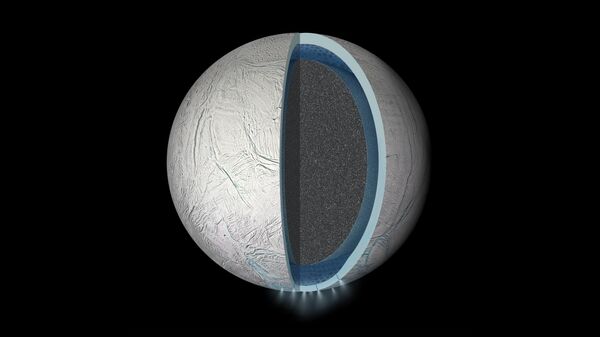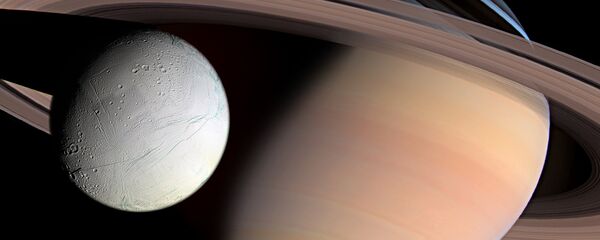Last week, NASA scientists studying data from the Cassini spacecraft announced that one of Saturn's moons may provide the conditions for alien life.
Diving close to the icy surface of the planet's sixth-largest moon, Enceladus, Cassini analyzed the plumes escaping from cracks in the ice. The plumes are mostly composed of water, but also contain other chemical elements such as methane, carbon dioxide and ammonia.
Two years ago, Cassini discovered tiny particles of silica, a material which is dissolved from rocks. This led the scientists to believe that there is hot rock below the surface of Enceladus which is reacting chemically with water.
The discovery of hydrogen in the plume would later prove this hypothesis; Cassini discovered that it contained the element in October 2015. Last week, NASA scientists published the results of their investigation in the journal Science.
David Rothery, Professor of Planetary Geosciences at the Open University, told Radio Sputnik that the discovery is very important because it shows the existence of hydrothermal reactions similar to that which took place in the deep oceans of the Earth when life began around 3.7 billion years ago.
"Hydrothermal reactions between the water and the rock and hydrothermal reactions are something inside the Earth's deep oceans that life can 'piggy-back' on. Life can take the hydrogen, react it with carbon dioxide, produce methane, extract energy, and there are chemical nutrients from the rock which are being dissolved as well," Rothery explained.
"You've got nutrients and an energy source, so there could be life down there. Life hasn't been found; we've found the perfect conditions in which life can exist, though."
"That might be where life began on Earth. Life didn't begin in the sunshine, breathing oxygen. There was no oxygen when life started on Earth. So, everything seems to fit into place. If life can start on the Earth, at vents with chemistry going on in the deep oceans, it could start at vents with no sunlight in the deep oceans on Saturn's moon Enceladus. All the conditions are correct."
The scientists said that if life does exist on Enceladus, it would probably take the form of microorganisms. The oldest life-forms on Earth, called archaea, are single-celled organisms which exist in the deep oceans of the Earth.
They feed off the Earth's rocks and are in turn eaten by more complex animals like shrimp. However, it is unlikely that such a food chain has developed on Enceladus.
"It's unlikely on such a tiny, impoverished world as Enceladus. It's small, it's only 500km in diameter, there's not a lot of energy so you're not going to get bacteria-like organisms and shrimp and fish and sharks and stuff like that. It's going to be a much more basic, very simple ecosystem if it exists at all."
"But it will be very exciting to discover it, because we only know at the moment that life has begun at one place, which is on Earth. If we can find life under the ice on Enceladus, that will tell us that life began there as well, independently of life on Earth, and that will be an amazing finding because we don't know how likely it is for life to start," Rothery explained.
"Most stars have planets; we've demonstrated that now, and some of these planets will have the right conditions for life. So if they have the right conditions for life, will life have started there? At the moment, we can't answer that because we only have one example of life starting: on this planet. If we find that life started on Enceladus as well, then we're going to have to say, look at all those other planets around other stars, there must be life there as well. This is why tracking down Enceladus and finding whether it really does have life is a very important scientific discovery."
The task of finding life on Enceladus will be up to future space missions. Discovering conditions that would allow life on Enceladus was one of the final achievements of the Cassini space probe, a joint mission between NASA, the European Space Agency and the Italian space agency, Agenzia Spaziale Italiana, which was launched in 1997.
On April 22 it begins the final stage of its mission, a set of several plunges between the planet and the inner edge of its rings in order to send scientists information about Saturn's gravitational and magnetic fields and the composition of its rings and clouds.
After it has completed the mission, Cassini will maneuver into the upper atmosphere of the gas giant planet and burn up like a meteor. Cassini's fiery end eliminates any chance of the probe someday colliding with one of Saturn's 62 moons and contaminating them with microbes from Earth that managed to survive the trip across the solar system.
Have you heard the news? Sign up to our Telegram channel and we'll keep you up to speed!



